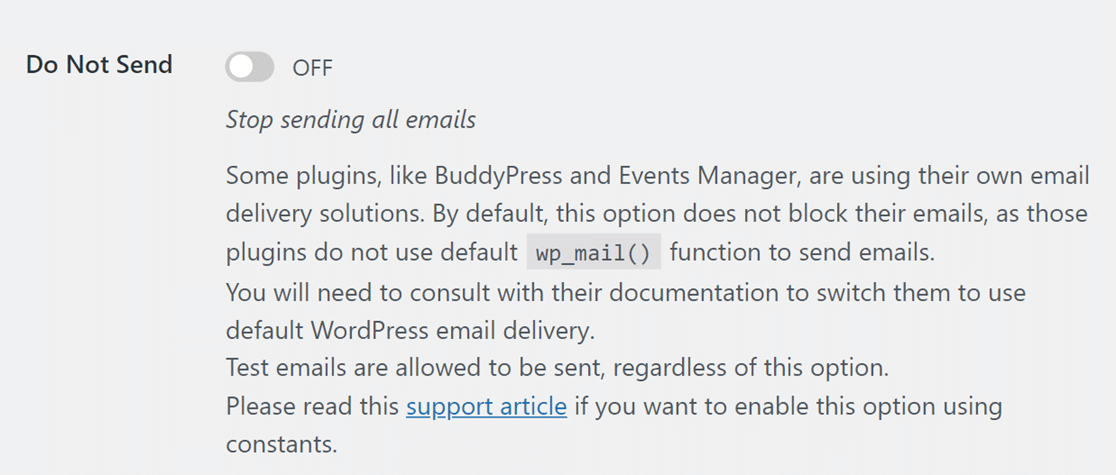AI Summary
Would you like to learn more about the miscellaneous settings in WP Mail SMTP? These settings include disabling weekly email summaries, hiding announcements, uninstalling WP Mail SMTP, and more.
This tutorial will cover all of the miscellaneous settings available in WP Mail SMTP.
Accessing Miscellaneous Settings
To access the miscellaneous settings in WP Mail SMTP, you’ll need to go to WP Mail SMTP » Settings. Then click on the Misc tab at the top of the page.

On the next screen, you’ll see various miscellaneous settings. We’ll explain what each of these settings does in the following sections.
Do Not Send

WP Mail SMTP alters the functionality of the wp_mail function to ensure email delivery via your selected mailer. Enabling this option will stop all emails from your WordPress site that are using the wp_mail function.
You can block all outgoing emails from WP Mail SMTP by setting the Do Not Send toggle button to the ON position.
Hide Announcements

Every so often, the WP Mail SMTP team sends notices to your WordPress dashboard, ranging from important announcements to a friendly request to consider creating a plugin review.
To stop seeing any such announcements from WP Mail SMTP, simply enable this Hide Announcements option.
Hide Email Delivery Errors

WP Mail SMTP notifies you about the underlying cause for unsuccessful email deliveries. These error messages can be helpful in identifying the reason for failed email attempts.
To hide these alerts from showing up on your site’s WP Mail SMTP plugin page, toggle on the Hide Email Delivery Errors option.
Hide Dashboard Widget

With the WP Mail SMTP dashboard widget, you can view a summary of your email logs at a glance. This widget will automatically appear on your WordPress dashboard as soon as you have installed and activated the plugin.
If you’d prefer to hide this widget from the dashboard, simply enable the Hide Dashboard Widget option.
Disable Email Summaries

WP Mail SMTP gathers the statistics about your emails and sends them to your inbox each week. You can opt to stop receiving these summaries by setting the Disable Email Summaries toggle button to the ON position.
Optimize Email Sending

This option enables asynchronous email sending, meaning emails are sent in the background without affecting the loading speed of your web pages. This can be beneficial for forms like contact forms, newsletter signups, user registrations, and checkout screens, where a faster response time can improve user experience.
To enable this feature, simply toggle the Optimize Email Sending option to the ON position.
Note: Enabling this setting is not recommended for users with low-traffic sites, as this may increase email delivery time substantially. We suggest setting up a system cron job to ensure your emails are sent on a regular schedule and with a short delay. This setting is also not intended to fix email delivery issues. For debugging sending issues, check out our guide.
Email Rate Limiting

To avoid exceeding your email provider’s sending limits, this feature allows you to set the maximum number of emails your website can send in a given time period—per minute, hour, day, week, or month.
If an email exceeds this limit, it’s automatically scheduled for later sending to comply with your provider’s limits, ensuring smooth email delivery. To set your sending limits, toggle on the Email Rate Limiting option.
When setting multiple limits, only emails that fall within all specified limits are sent immediately. For example, if you set a limit of 10 emails per minute and 5 emails per hour, only 5 emails will be sent in the next hour to respect the hourly limit.
Note: This feature may not be suitable for low-traffic sites as it could significantly delay email delivery. To maintain a consistent email delivery schedule and minimize delays, we suggest setting up a system cron job. For instructions on creating a system cron job, consult the official WordPress documentation.
Uninstall WP Mail SMTP

Deleting the WP Mail SMTP plugin the typical way (using the Delete option on your WordPress Plugins page) will not fully remove the data and will keep your settings, email logs, and saved keys.
This was designed to make sure that your data and specifics are not lost in the case of accidentally deleting the plugin or when removing the plugin for troubleshooting.
If you would like to delete the WP Mail SMTP plugin along with all your settings, email logs, and saved keys, you’ll first need to toggle on the Uninstall WP Mail SMTP option. Then, deactivate and delete WP Mail SMTP from your site’s Plugins page to completely remove the plugin.
That’s it! You’ve now successfully familiarized yourself with the miscellaneous settings in WP Mail SMTP.
Next, would you like to learn how to troubleshoot issues in WP Mail SMTP? Be sure to check out our guide on troubleshooting WP Mail SMTP for more details.
